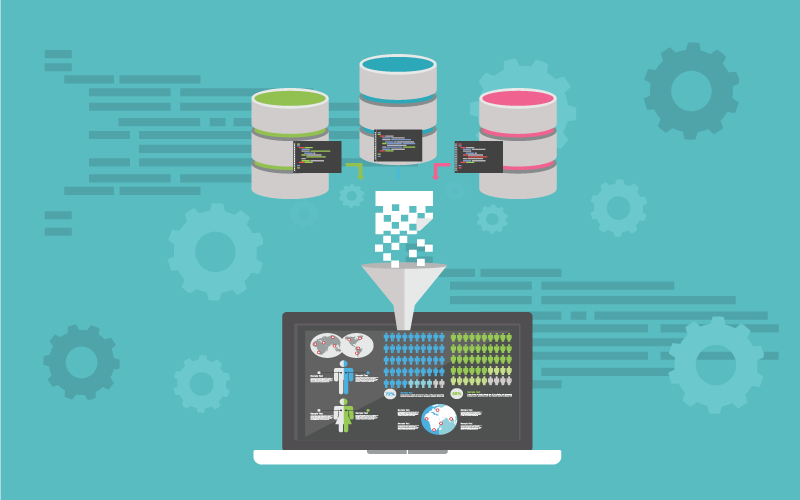Big Data is the silent champion behind every successful marketing campaign these days. Sales and marketing departments use data exhaustively to get to know their target audiences, track leads, create buyer personas, and personalize customer offerings. But, not all the data that filters through your database is deemed usable. A major chunk of it is unstructured, raw and incomplete. Therefore, businesses need to ensure they cleanse their databases continuously.
What Is Data Cleansing?

Data cleansing, also called scrubbing, means cleaning your in-house databases to get rid of corrupt and incorrect records. Data is considered cleansed when it has the following three attributes:
Completeness – Clean data is considered ideal when it is complete, meaning all the fields or categories are duly filled out, leaving no section blank. This is often a challenge because your employees may forget to note down certain details during the primary data collection process. For instance, say, your client had specified a need over the phone but the executive forgot to fill it in the notes that have to be used when you get on another call with the same client. Losing out on such a critical piece of information renders data incomplete.
Consistency – It is near impossible to have a fully consistent email database. There will be scenarios where you will not know which two different data values are correct. To counter this problem, it is advisable to track down the primary source. If that is not possible, engage the services of a reliable third-party data provider like Span Global for cross-referencing the incomplete entries and validating the right one.
Uniformity – Data is all about keeping the values and formats in line with each other. For example, if your database is tracking the weight of people or the speed of cars, make sure that the unit of measurement is uniformly maintained throughout the dataset.
Why Is Data Cleansing a Must?

Clean data provides actionable insights that help in business decision making. Here are a few advantages of data cleaning that you must know
Increases Customer Acquisition
Cleansed data helps in identifying and creating an accurate prospect list. It reduces the chance of encountering dead email addresses, phone numbers, etc., thus, ensuring a better ROI on marketing campaigns. It also helps brands personalize their offerings according to customer preferences. An enterprise can boost its customer acquisition efforts through targeted marketing because of clean data.
Increases Sales and Revenue
If you know what your customers are looking for, your sales are bound to go up. Hygienic data helps in creating a more accurate prospect list. Marketing to the rightly identified prospects leads to a higher rate of conversion, acquisition, and retention. Ensure better customer engagement with the help of clean data and boost your sales.
Makes Decision Making More Accurate
High-quality customer data is critical to your company’s success. Yet, countless enterprises are unable to prioritize the importance of cleansed data. Businesses must understand that precision analytics is conducted only on clean data. Simply put, cleaner your data, more accurate the marketing analysis. Make more engaging marketing campaigns with the help of cleansed data.
Boosts Overall Productivity
Cleansed data also helps business leaders ensure that their sales and marketing teams are not chasing after unqualified or duplicate leads. Getting rid of out-of-date information and invalid vendor files improves the overall productivity. Clean data also reduces the risk of fraud as the leaders have accurate insights on payments received and refunds initiated.
How to Cleanse Data?
Before devising a step-by-step data cleansing strategy, list out your overall expectations from this exercise and develop an execution framework. Even though data cleansing strategies may differ from company to company, here are a few steps that generally aid most businesses in achieving superior data hygiene –
Step 1. Develop a Framework
The first step in cleansing your data is to devise a strategy on how best to approach all the customer information available. This may seem overwhelming given the size of databases today. Also, ensure that you involve top-level management and stake-holders to supervise the development of the data framework.
Step 2. Standardize Processes
The most prominent source of data corruption is its first point of entry. Devise a uniform template to standardize the way data enters into your system. Allowing customer information to enter your database in an unstructured manner will reduce its efficiency and make it dirty. Detail out Standard Operating Procedures (SOPs) to categorize your data processes. Standardization also ensures that all your team members follow a set of prescribed methods for data acquisition.
Step 3. Validate Data
After developing a framework and putting the SOPs in action, validate the incoming data’s accuracy in real-time. You can use list exports, email list cleaners, and verifiers to do this. Also, utilize data analytics tools to cross-reference and merge various datasets for completing the validation process. Automating the validation process will save you a lot of man-hours and increase the efficiency of your marketing department.
Step 4. Scan for Duplicity
Duplicity in data poses a real challenge and drives up your marketing costs. Duplicate data entries should be eliminated from your database with the help of different data cleaning tools. These tools are specifically designed to automatically analyze bulk raw data and flag dupes. Duplication damages your brand’s reputation and hampers customer engagement.
Step 5. Append Data
After normalizing, validating, and scrubbing duplicate data, use third-party databases offered by Span Global to append it. Data appending refers to adding new information to your existing database. This makes your database richer. For instance, data appending can paint a better picture of your company’s most profitable clients.
Over to You
Data sets replete with inaccuracies, mixed formats, and duplication are as good as a mud pit. Therefore, look for good data within Big Data. Dedicate optimal time and resources to cleansing your mailing database and increasing your annual revenues.